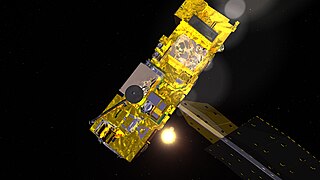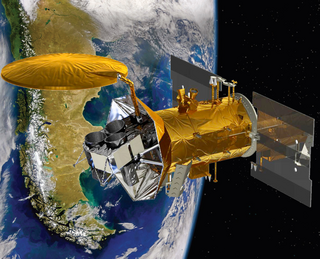
Explorer 1 was the first satellite launched by the United States in 1958 and was part of the U.S. participation in the International Geophysical Year (IGY). The mission followed the first two satellites the previous year; the Soviet Union's Sputnik 1 and Sputnik 2, beginning the Cold War Space Race between the two nations.

James Alfred Van Allen was an American space scientist at the University of Iowa. He was instrumental in establishing the field of magnetospheric research in space.

The Goddard Space Flight Center (GSFC) is a major NASA space research laboratory located approximately 6.5 miles (10.5 km) northeast of Washington, D.C. in Greenbelt, Maryland, United States. Established on May 1, 1959 as NASA's first space flight center, GSFC employs approximately 10,000 civil servants and contractors. Named in recognition of American rocket propulsion pioneer Robert H. Goddard, it is one of ten major NASA field centers. GSFC is partially within the former Goddard census-designated place; it has a Greenbelt mailing address.

The Goddard Institute for Space Studies (GISS) is a laboratory in the Earth Sciences Division of NASA's Goddard Space Flight Center affiliated with the Columbia University Earth Institute. The institute is located at Columbia University in New York City. It was named after Robert H. Goddard, American engineer, professor, physicist and inventor who is credited with creating and building the world's first liquid-fueled rocket.

The atmospheric infrared sounder (AIRS) is one of six instruments flying on board NASA's Aqua satellite, launched on May 4, 2002. The instrument is designed to support climate research and improve weather forecasting.

Aquarius was a NASA instrument aboard the Argentine SAC-D spacecraft. Its mission was to measure global sea surface salinity to better predict future climate conditions.

C/NOFS, or Communications/Navigation Outage Forecasting System was a USAF satellite developed by the Air Force Research Laboratory (AFRL) Space Vehicles Directorate to investigate and forecast scintillations in the Earth's ionosphere. It was launched by an Orbital Sciences Corporation Pegasus-XL launch vehicle at 17:02:48 UTC on 16 April 2008 and decayed on 28 November 2015.
Space Network (SN) is a NASA program that combines space and ground elements to support spacecraft communications in Earth vicinity. The SN Project Office at Goddard Space Flight Center (GSFC) manages the SN, which consists of:

Goddard Space Flight Center is NASA's first, and oldest, space center. It is named after Robert H. Goddard, the father of modern rocketry. Throughout its history, the center has managed, developed, and operated many notable missions, including the Cosmic Background Explorer, the Hubble Space Telescope, the Tracking and Data Relay Satellite System (TDRSS), the Lunar Reconnaissance Orbiter, and the Solar Dynamics Observatory.

Gravity and Extreme Magnetism Small Explorer mission was a NASA space observatory mission. The main scientific goal of GEMS was to be the first mission to systematically measure the polarization of X-ray sources. GEMS would have provided data to help scientists study the shape of spacetime that has been distorted by a spinning black hole's gravity and the structure and effects of the magnetic fields around neutron stars. It was cancelled by NASA in June 2012 for potential cost overruns due to delays in developing the technology and never moved into the development phase.
There are NASA facilities across the United States and around the world. NASA Headquarters in Washington, DC provides overall guidance and political leadership to the agency. There are 10 NASA field centers, which provide leadership for and execution of NASA's work. All other facilities fall under the leadership of at least one of these field centers. Some facilities serve more than one application for historic or administrative reasons. NASA has used or supported various observatories and telescopes, and an example of this is the NASA Infrared Telescope Facility. In 2013 a NASA Office of the Inspector General's (OIG) Report recommended a Base Realignment and Closure Commission (BRAC) style organization to consolidate NASA's little used facilities. The OIG determined at least 33 of NASA's 155 facilities were underutilized.

Frank Bethune McDonald was an American astrophysicist who helped design scientific instruments for research flights into space. He was a key force behind several initiatives and programs of the National Aeronautics and Space Administration, for which he served as chief scientist.

Aprille J. Ericsson-Jackson is an American aerospace engineer. Ericsson-Jackson is the first African-American woman to receive a Ph.D. in mechanical engineering from Howard University and the first African-American woman to receive a Ph.D. in engineering at the National Aeronautics and Space Administration (NASA) Goddard Space Flight Center (GSFC).
Epaminondas George Aristotle Alexander Stassinopoulos was an ethnic Greek, German-born American astrophysicist, author, and Resistance member against the Nazis occupying Greece during World War II. He served as the Head of the Radiation Physics Office at NASAs Goddard Space Flight Center until 2006, when he transitioned to Emeritus status until 2021. He was the author of numerous papers and articles in the field of space radiation.

Robert Eugene Bourdeau was an American physicist known for major contributions to the study of the ionosphere, plasma physics and radio science using space vehicles including satellites and rockets. Among his many achievements was the launch on November 3, 1960, of Explorer 8 from Cape Canaveral, Florida. This occurred during his 16-year career at the National Aeronautics and Space Administration (NASA). He was both Project Manager and Project Scientist for Explorer 8 which added significant knowledge to the understanding of these fields.

Mian Chin is a Chinese atmospheric chemist. She is a physical scientist in the atmospheric chemistry and dynamics laboratory in the earth science division at Goddard Space Flight Center. Her research includes aerosol-cloud-chemistry-climate interactions. She received the NASA Exceptional Achievement Medal in 2005.
Llewelyn Robert Owen Storey is a British physicist and electrical engineer who has worked and lived most of his adult life in France. He is known for his research on the Earth's atmosphere, especially whistlers—very low frequency (VLF) radio waves caused by lightning strikes—and the plasmasphere. He was the first person to prove whistlers are caused by lightning strikes and to deduce the plasmasphere's existence. He was heavily involved in designing scientific instruments for FR-1, a 1965 French-American satellite, and subsequent studies and experiments using data FR-1 collected.

William Ka Ming Lau is a senior scientist at the Earth System Science Interdisciplinary Center, a research center at the University of Maryland and an Adjunct Professor of the Department of Atmospheric and Oceanic Sciences at the University of Maryland. A physicist by training, his research spans over 4 decades covering a wide range of topics in climate dynamics, tropical meteorology, ocean-atmosphere coupling, aerosol-water cycle interactions, and climate variability and change. Lau conducted pioneering research on atmospheric teleconnection, and the global monsoon climate system. He discovered the aerosol-monsoon regional feedback mechanism, i.e., the Elevated Heat Pump (EHP) effect that strongly modulate climate change in Asian monsoon regions. He was the senior author of a popular research reference book, “Intraseasonal Variability in the Atmosphere-Ocean Climate System”. As of November 2020, he has coauthored 297 refereed papers, with total citation = 33,932, h-index=101.
Anne Ritger Douglass is atmospheric physicist known for her research on chlorinated compounds and the ozone layer.












